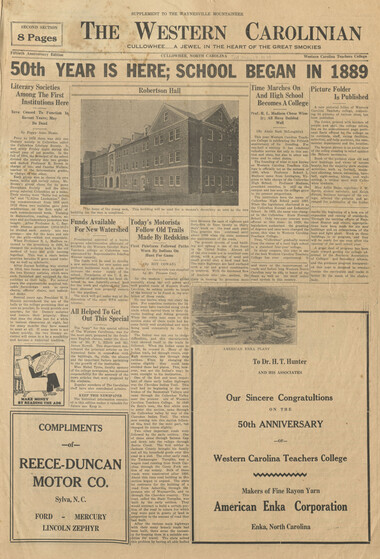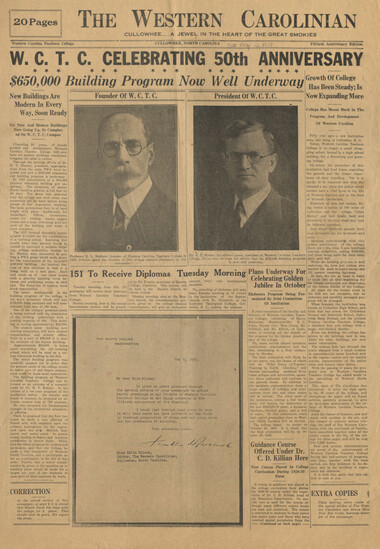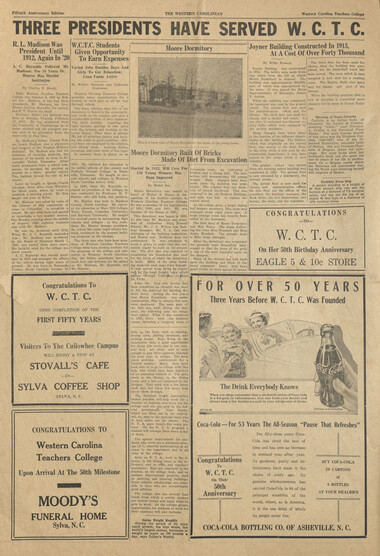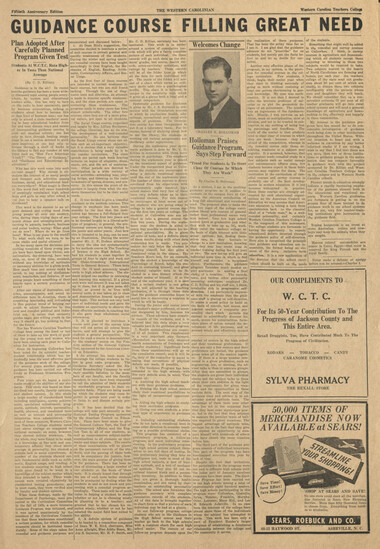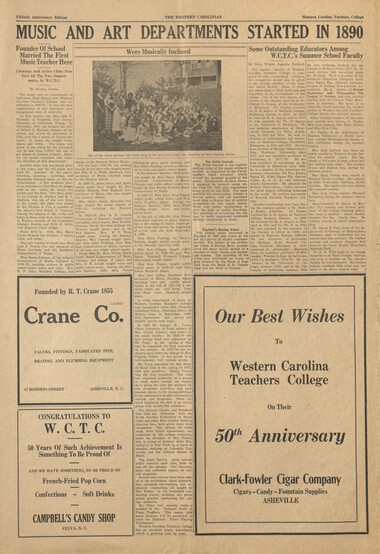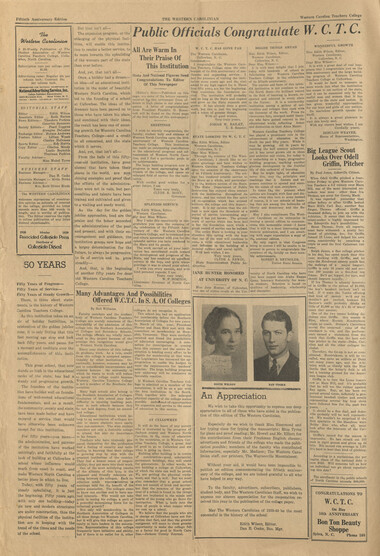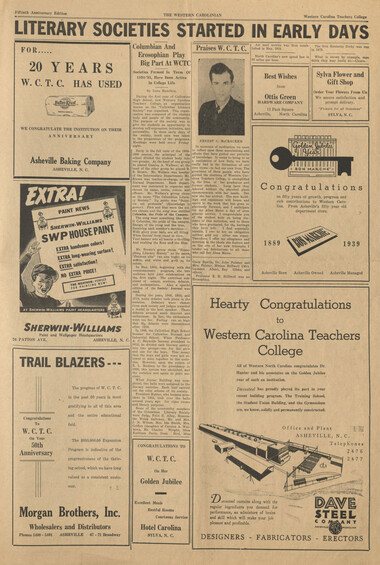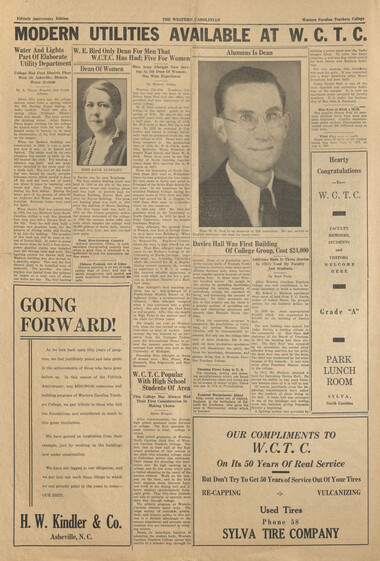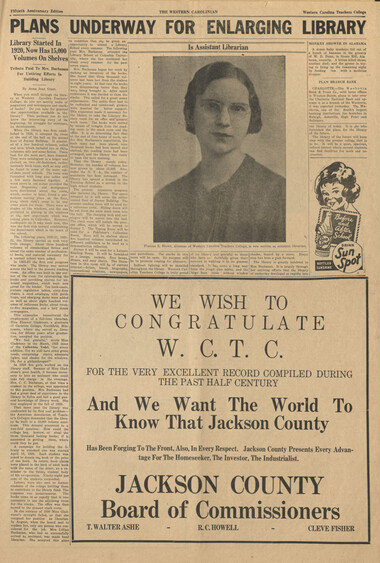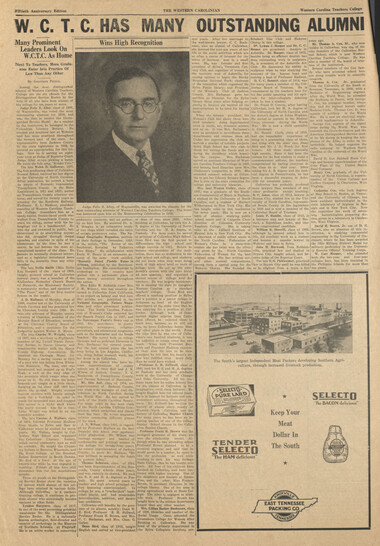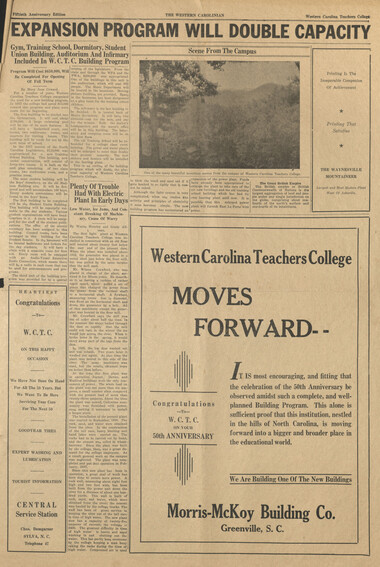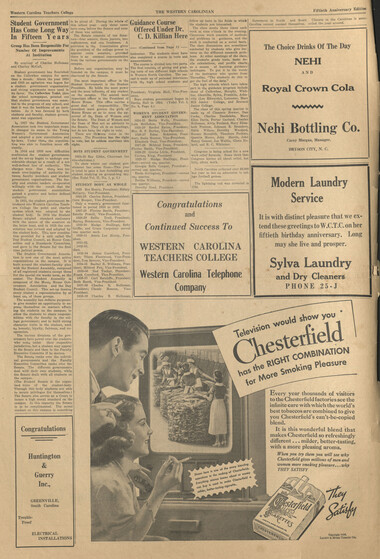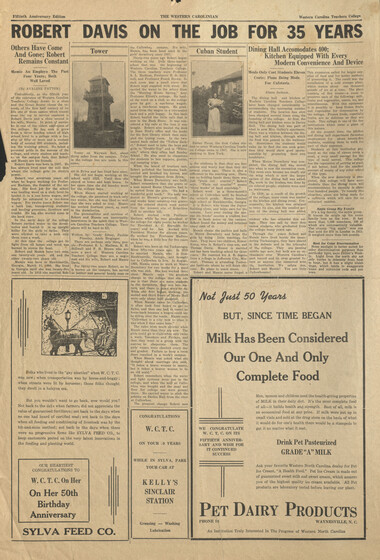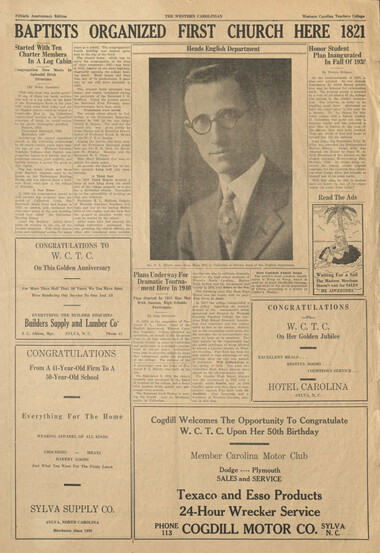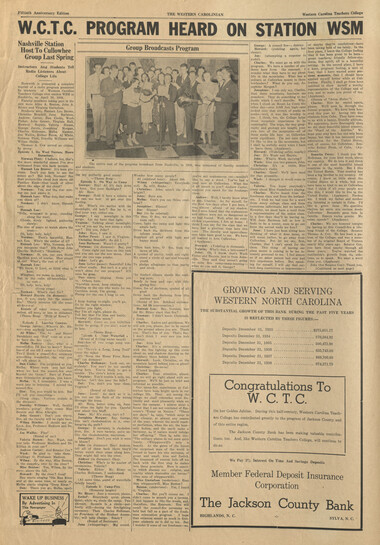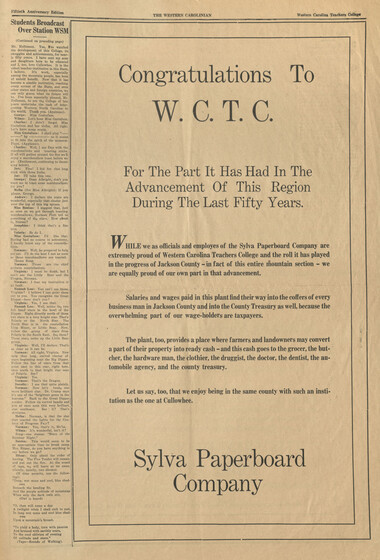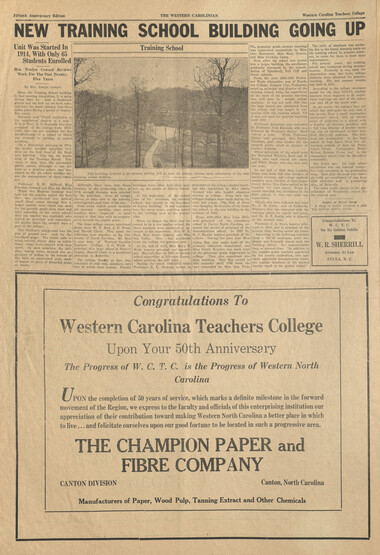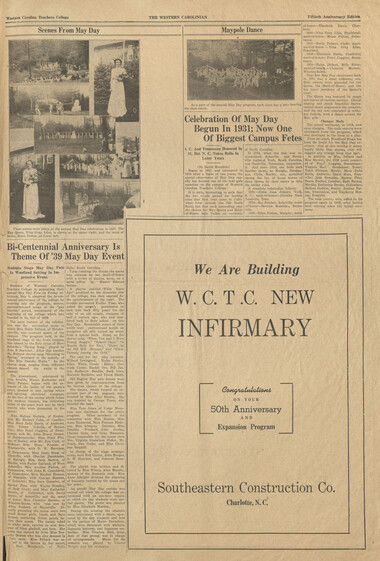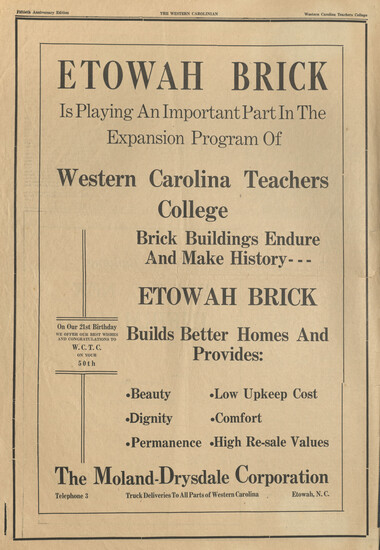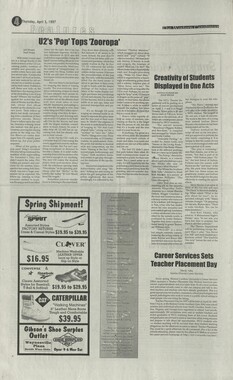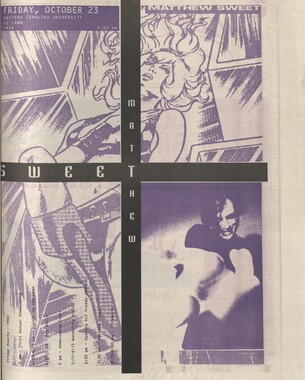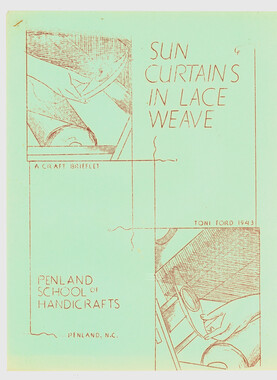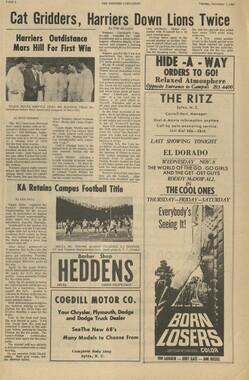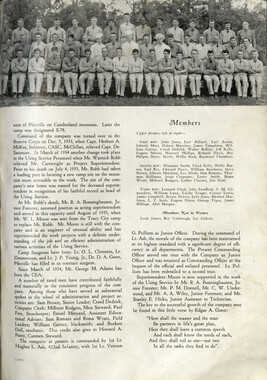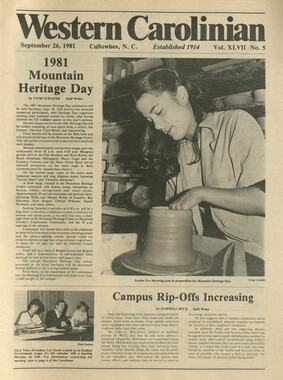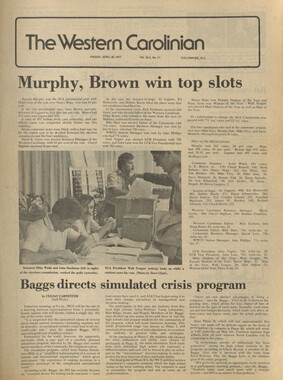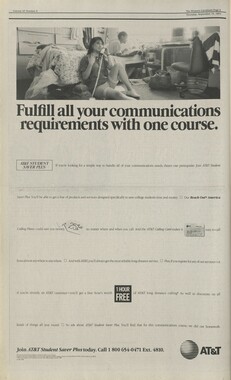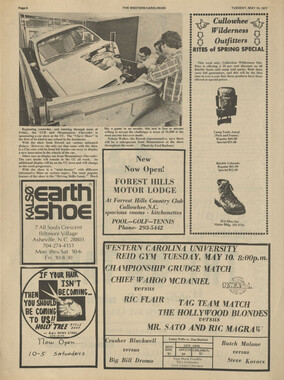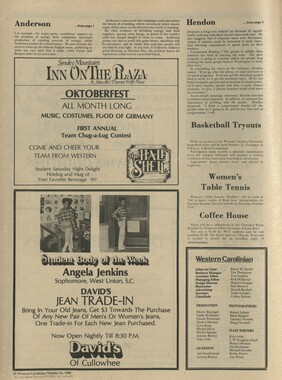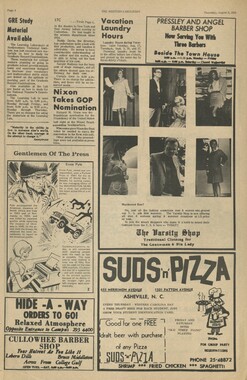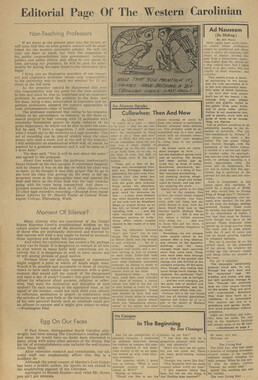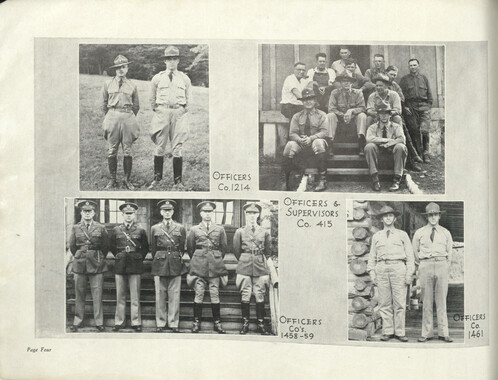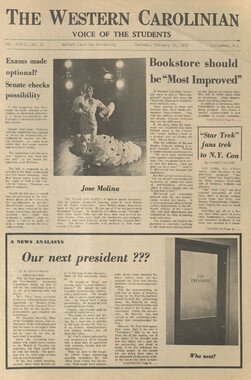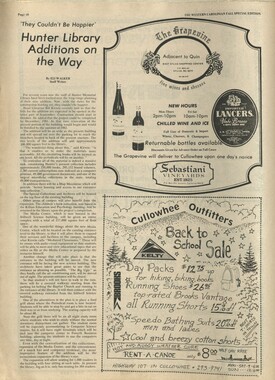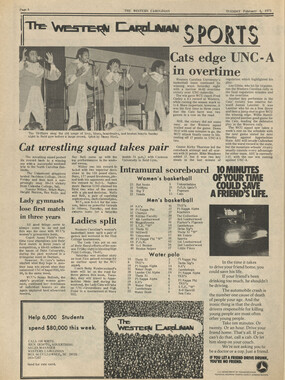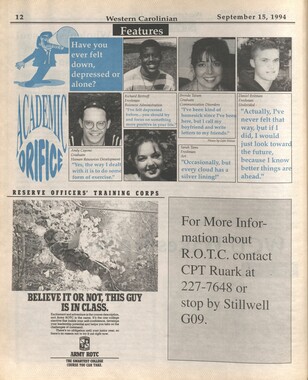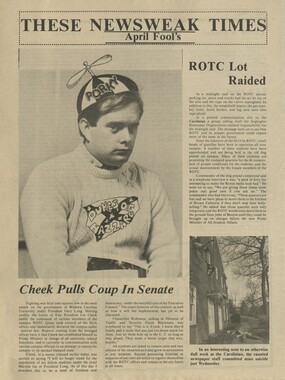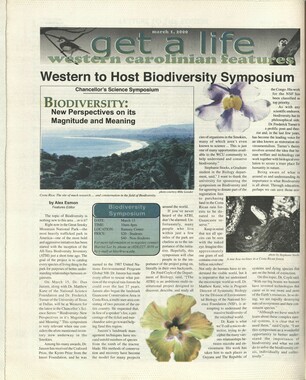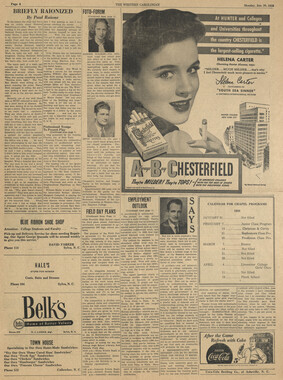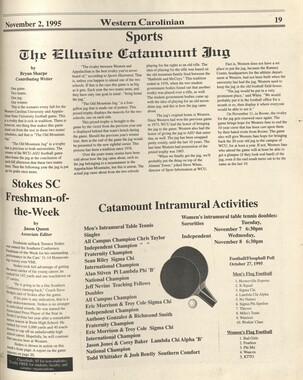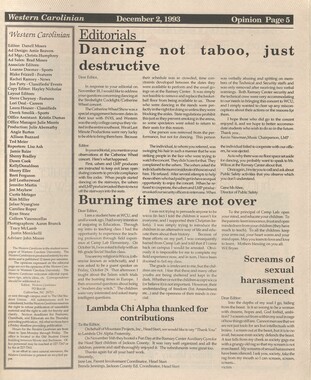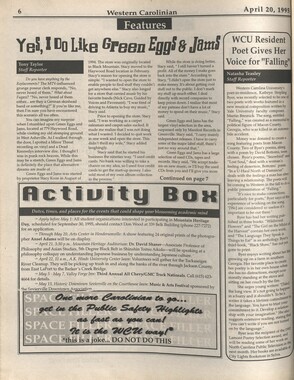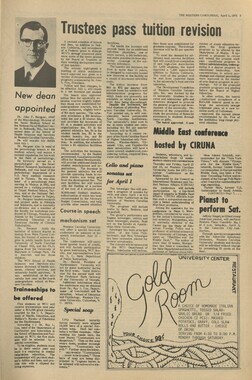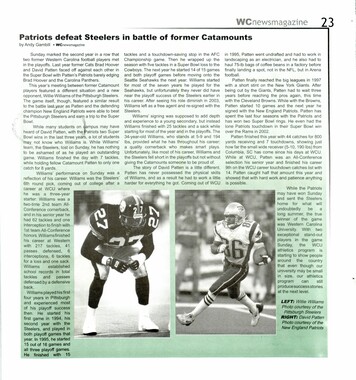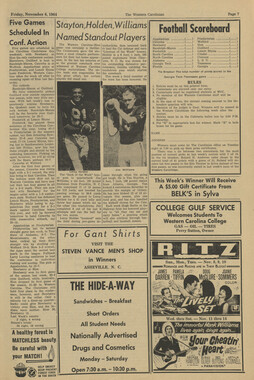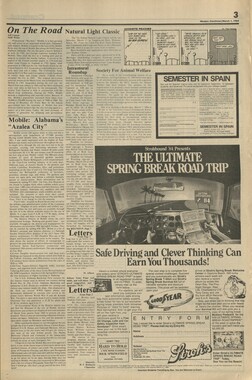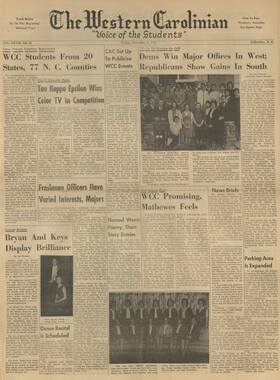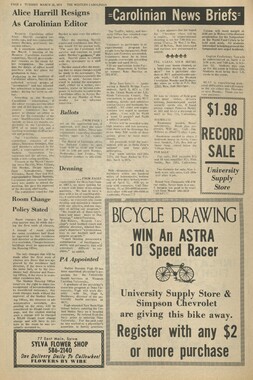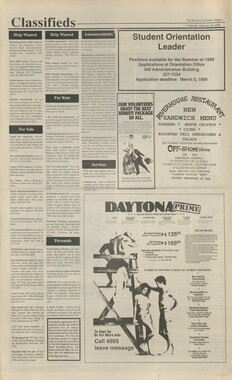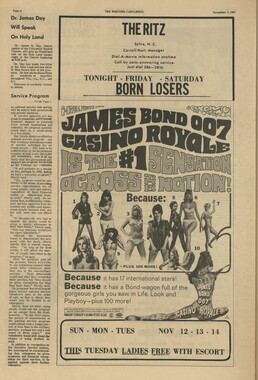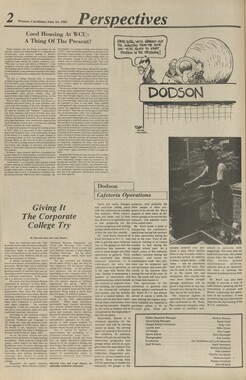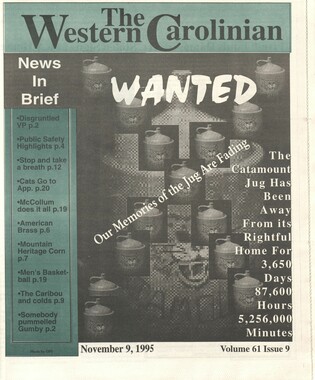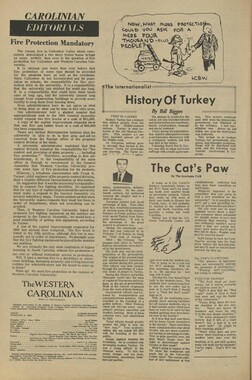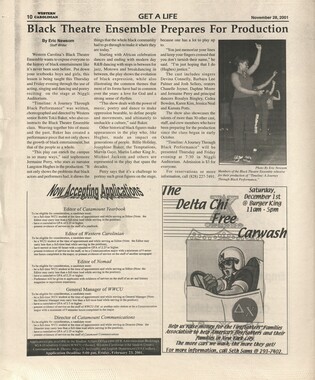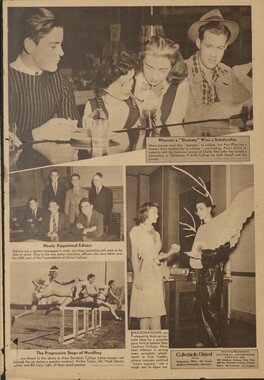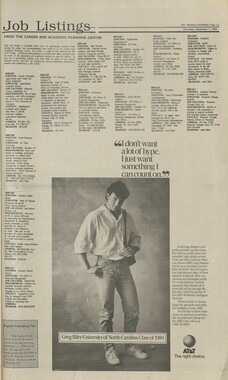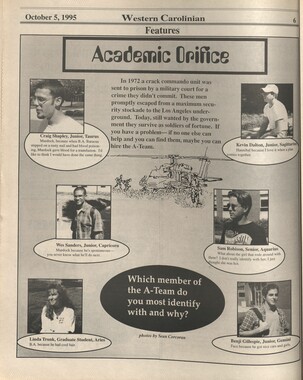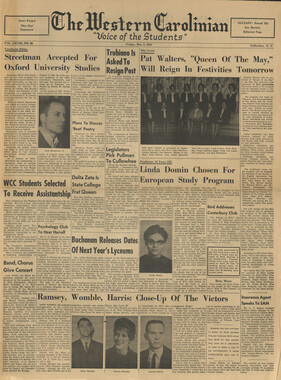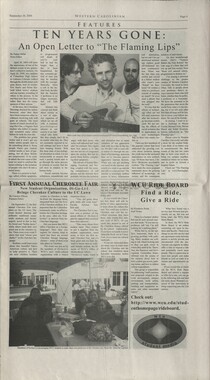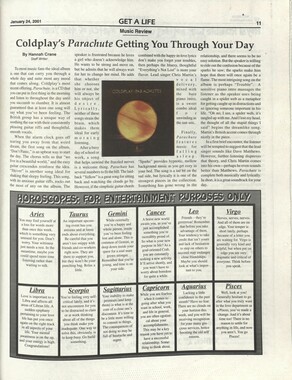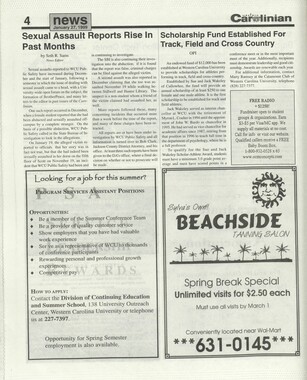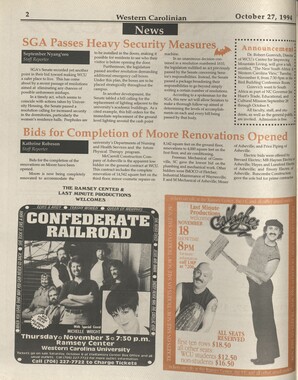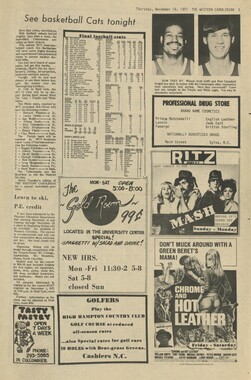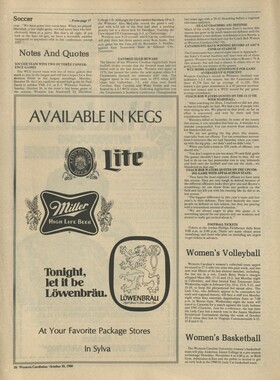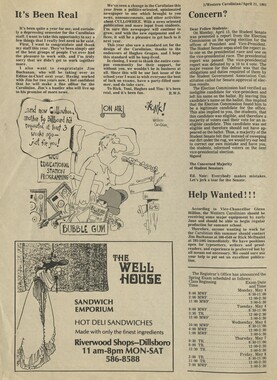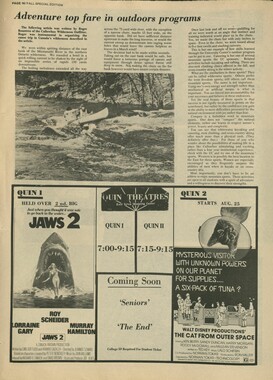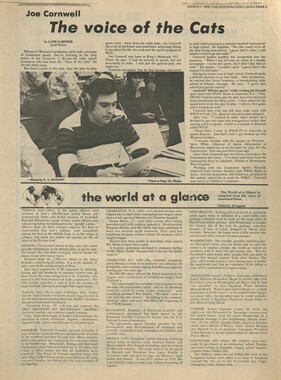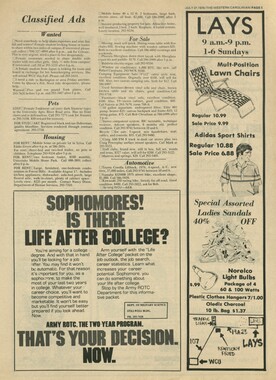Western Carolina University (21)
View all
- Canton Champion Fibre Company (2308)
- Cherokee Traditions (291)
- Civil War in Southern Appalachia (165)
- Craft Revival (1942)
- George Masa Collection (135)
- Great Smoky Mountains - A Park for America (2901)
- Highlights from Western Carolina University (422)
- Horace Kephart (941)
- Journeys Through Jackson (159)
- LGBTQIA+ Archive of Jackson County (85)
- Oral Histories of Western North Carolina (314)
- Picturing Appalachia (6798)
- Stories of Mountain Folk (413)
- Travel Western North Carolina (153)
- Western Carolina University Fine Art Museum Vitreograph Collection (129)
- Western Carolina University Herbarium (92)
- Western Carolina University: Making Memories (738)
- Western Carolina University Publications (2491)
- Western Carolina University Restricted Electronic Theses and Dissertations (146)
- Western North Carolina Regional Maps (71)
- World War II in Southern Appalachia (131)
University of North Carolina Asheville (6)
View all
- Allanstand Cottage Industries (62)
- Appalachian National Park Association (53)
- Bennett, Kelly, 1890-1974 (1463)
- Berry, Walter (76)
- Brasstown Carvers (40)
- Carver, George Washington, 1864?-1943 (26)
- Cathey, Joseph, 1803-1874 (1)
- Champion Fibre Company (233)
- Champion Paper and Fibre Company (297)
- Cherokee Indian Fair Association (16)
- Cherokee Language Program (22)
- Crowe, Amanda (40)
- Edmonston, Thomas Benton, 1842-1907 (7)
- Ensley, A. L. (Abraham Lincoln), 1865-1948 (275)
- Fromer, Irving Rhodes, 1913-1994 (70)
- George Butz (BFS 1907) (46)
- Goodrich, Frances Louisa (120)
- Grant, George Alexander, 1891-1964 (96)
- Heard, Marian Gladys (60)
- Kephart, Calvin, 1883-1969 (15)
- Kephart, Horace, 1862-1931 (313)
- Kephart, Laura, 1862-1954 (39)
- Laney, Gideon Thomas, 1889-1976 (439)
- Masa, George, 1881-1933 (61)
- McElhinney, William Julian, 1896-1953 (44)
- Niggli, Josephina, 1910-1983 (10)
- North Carolina Park Commission (105)
- Osborne, Kezia Stradley (9)
- Owens, Samuel Robert, 1918-1995 (11)
- Penland Weavers and Potters (36)
- Roberts, Vivienne (15)
- Roth, Albert, 1890-1974 (142)
- Schenck, Carl Alwin, 1868-1955 (1)
- Sherrill's Photography Studio (2565)
- Southern Highland Handicraft Guild (127)
- Southern Highlanders, Inc. (71)
- Stalcup, Jesse Bryson (46)
- Stearns, I. K. (213)
- Thompson, James Edward, 1880-1976 (226)
- United States. Indian Arts and Crafts Board (130)
- USFS (683)
- Vance, Zebulon Baird, 1830-1894 (1)
- Weaver, Zebulon, 1872-1948 (58)
- Western Carolina College (230)
- Western Carolina Teachers College (282)
- Western Carolina University (2008)
- Western Carolina University. Mountain Heritage Center (18)
- Whitman, Walt, 1819-1892 (10)
- Wilburn, Hiram Coleman, 1880-1967 (73)
- Williams, Isadora (3)
- Cain, Doreyl Ammons (0)
- Crittenden, Lorraine (0)
- Rhodes, Judy (0)
- Smith, Edward Clark (0)
- Appalachian Region, Southern (2693)
- Asheville (N.C.) (1936)
- Avery County (N.C.) (26)
- Blount County (Tenn.) (195)
- Buncombe County (N.C.) (1672)
- Cherokee County (N.C.) (283)
- Clay County (N.C.) (556)
- Graham County (N.C.) (236)
- Great Smoky Mountains National Park (N.C. and Tenn.) (519)
- Haywood County (N.C.) (3569)
- Henderson County (N.C.) (70)
- Jackson County (N.C.) (4913)
- Knox County (Tenn.) (35)
- Knoxville (Tenn.) (13)
- Lake Santeetlah (N.C.) (10)
- Macon County (N.C.) (420)
- Madison County (N.C.) (215)
- McDowell County (N.C.) (39)
- Mitchell County (N.C.) (132)
- Polk County (N.C.) (35)
- Qualla Boundary (982)
- Rutherford County (N.C.) (76)
- Swain County (N.C.) (2182)
- Transylvania County (N.C.) (270)
- Watauga County (N.C.) (12)
- Waynesville (N.C.) (86)
- Yancey County (N.C.) (72)
- Aerial Photographs (3)
- Aerial Views (60)
- Albums (books) (4)
- Articles (1)
- Artifacts (object Genre) (228)
- Bibliographies (1)
- Biography (general Genre) (2)
- Cards (information Artifacts) (38)
- Clippings (information Artifacts) (191)
- Copybooks (instructional Materials) (3)
- Crafts (art Genres) (622)
- Depictions (visual Works) (21)
- Design Drawings (1)
- Drawings (visual Works) (185)
- Envelopes (73)
- Exhibitions (events) (1)
- Facsimiles (reproductions) (1)
- Fiction (general Genre) (4)
- Financial Records (12)
- Fliers (printed Matter) (67)
- Glass Plate Negatives (381)
- Guidebooks (2)
- Internegatives (10)
- Interviews (815)
- Land Surveys (102)
- Letters (correspondence) (1013)
- Manuscripts (documents) (618)
- Maps (documents) (177)
- Memorandums (25)
- Minutes (administrative Records) (59)
- Negatives (photographs) (6090)
- Newsletters (1290)
- Newspapers (2)
- Notebooks (8)
- Occupation Currency (1)
- Paintings (visual Works) (1)
- Pen And Ink Drawings (1)
- Periodicals (193)
- Personal Narratives (10)
- Photographs (12976)
- Plans (maps) (1)
- Poetry (5)
- Portraits (4568)
- Postcards (329)
- Programs (documents) (181)
- Publications (documents) (2443)
- Questionnaires (65)
- Relief Prints (26)
- Sayings (literary Genre) (1)
- Scrapbooks (282)
- Sheet Music (2)
- Slides (photographs) (402)
- Songs (musical Compositions) (2)
- Sound Recordings (796)
- Specimens (92)
- Speeches (documents) (18)
- Tintypes (photographs) (8)
- Transcripts (322)
- Video Recordings (physical Artifacts) (23)
- Text Messages (0)
- A.L. Ensley Collection (275)
- Appalachian Industrial School Records (7)
- Appalachian National Park Association Records (336)
- Axley-Meroney Collection (2)
- Bayard Wootten Photograph Collection (20)
- Bethel Rural Community Organization Collection (7)
- Blumer Collection (5)
- C.W. Slagle Collection (20)
- Canton Area Historical Museum (2110)
- Carlos C. Campbell Collection (462)
- Cataloochee History Project (64)
- Cherokee Studies Collection (4)
- Daisy Dame Photograph Album (5)
- Daniel Boone VI Collection (1)
- Doris Ulmann Photograph Collection (112)
- Elizabeth H. Lasley Collection (1)
- Elizabeth Woolworth Szold Fleharty Collection (4)
- Frank Fry Collection (95)
- George Masa Collection (173)
- Gideon Laney Collection (452)
- Hazel Scarborough Collection (2)
- Hiram C. Wilburn Papers (28)
- Historic Photographs Collection (236)
- Horace Kephart Collection (861)
- Humbard Collection (33)
- Hunter and Weaver Families Collection (1)
- I. D. Blumenthal Collection (4)
- Isadora Williams Collection (4)
- Jesse Bryson Stalcup Collection (47)
- Jim Thompson Collection (224)
- John B. Battle Collection (7)
- John C. Campbell Folk School Records (80)
- John Parris Collection (6)
- Judaculla Rock project (2)
- Kelly Bennett Collection (1482)
- Love Family Papers (11)
- Major Wiley Parris Civil War Letters (3)
- Map Collection (12)
- McFee-Misemer Civil War Letters (34)
- Mountain Heritage Center Collection (4)
- Norburn - Robertson - Thomson Families Collection (44)
- Pauline Hood Collection (7)
- Pre-Guild Collection (2)
- Qualla Arts and Crafts Mutual Collection (12)
- R.A. Romanes Collection (681)
- Rosser H. Taylor Collection (1)
- Samuel Robert Owens Collection (94)
- Sara Madison Collection (144)
- Sherrill Studio Photo Collection (2558)
- Smoky Mountains Hiking Club Collection (616)
- Stories of Mountain Folk - Radio Programs (374)
- The Reporter, Western Carolina University (510)
- Venoy and Elizabeth Reed Collection (16)
- WCU Gender and Sexuality Oral History Project (32)
- WCU Mountain Heritage Center Oral Histories (25)
- WCU Oral History Collection - Mountain People, Mountain Lives (71)
- WCU Students Newspapers Collection (1923)
- Western North Carolina Tomorrow Black Oral History Project (69)
- William Williams Stringfield Collection (2)
- Zebulon Weaver Collection (109)
- African Americans (390)
- Appalachian Trail (35)
- Artisans (521)
- Cherokee art (84)
- Cherokee artists -- North Carolina (10)
- Cherokee language (21)
- Cherokee pottery (101)
- Cherokee women (208)
- Church buildings (190)
- Civilian Conservation Corps (U.S.) (111)
- College student newspapers and periodicals (2012)
- Dams (107)
- Dance (1023)
- Education (222)
- Floods (61)
- Folk music (1015)
- Forced removal, 1813-1903 (2)
- Forest conservation (220)
- Forests and forestry (1195)
- Gender nonconformity (4)
- Great Smoky Mountains National Park (N.C. and Tenn.) (181)
- Hunting (45)
- Landscape photography (25)
- Logging (119)
- Maps (83)
- Mines and mineral resources (8)
- North Carolina -- Maps (18)
- Paper industry (38)
- Postcards (255)
- Pottery (135)
- Railroad trains (72)
- Rural electrification -- North Carolina, Western (3)
- School integration -- Southern States (2)
- Segregation -- North Carolina, Western (5)
- Slavery (5)
- Sports (452)
- Storytelling (243)
- Waterfalls -- Great Smoky Mountains (N.C. and Tenn.) (66)
- Weaving -- Appalachian Region, Southern (280)
- Wood-carving -- Appalachian Region, Southern (328)
- World War, 1939-1945 (173)
Western Carolinian Volume 07 50th Anniversary
Item
Item’s are ‘child’ level descriptions to ‘parent’ objects, (e.g. one page of a whole book).
-
-
SUPPLEMENT TO THE WAYNESVILLE MOUNTAINEER SECOND SECTION 8 Pages The Western Carolinian CULLOWHEE^ A JEWEL IN THE HEART OF THE GREAT SMOKIES FiftietrTAnniversary" Edition CULLOWHEE, NORTH CAROLINA Western Carolina Teachers College 50th YEAR IS HERE; SCHOOL BEGAN IN 1889 Literary Societies Among The First Institutions Here lave Ceased To Function In Recent Years; May Be Dead By Peggy Anne Prior to 1834 there was only one literary society in Cullowhee called1 the Cullowhee Literary Society. 1' met every Friday night during the school year of ten months. In the fall of 1894, the principal of the school divided the society into two groups and named Professor B. Brown in charge of one, and Cassius Wallace, teacher of the intermediate grades, in charge of the other. Each group was to choose its own name, motto and society colors. Mr. Brown's group chose for its name Eosophian Society and the other group selected Columbian as a name. Their mottos were "Scitie iest poten*| tia" and "L'Altus Laudamius." During commencement from 1893 until 1912 these two societies gave joint celebrations on the first night of each commencement week. Training in declamation, reading, debate, essays and parliamentary procedure was taught. After Professor A. C. Reynolds became president (1912-1915) he divided each society into two groups— one for the boys and one for the girls—which met When Professor R. L. Madison returned to the presidency in 1920, he changed the societies back to the old method of boys and girls meeting together. This was a much better practice because it gave social training as well as scholastic. After Joyner building was erected in 1914, two room the two literary societies which wi each furnished and equipped by the societies as their hulls. For several years the organizations acquired valuable furnishings such as opera chairs, officers' chairs, and individual desks. Several years ago, President H. T. Hunter surrendered the use of the halls to the college promising that soon as possible, he would provide n quarters for the literary societies and restore their property. Since that time the clubs met for a while in various classrooms at night, but for many months they have ceased to meet at all. If some move is not taken quickly, the two literary societies will cease to a be a possibility and become a historical tradition. Robertson Hall The home of the young . building for the men is completed Funds Available For New Watershed Presidential approval of a works administration all" 119,668 to the Western Oarolinl State announced by Representative Zebufoq ecently. The funds will be used to develop a new watershed, lay new mains and perforni incidental work in order to the water supply of the school. Permission of the U. S. department of agriculture has been obtained to use federally-owned land for the work and rights-o£-way have been obtained rom property owner for the pipelines. The work will get under way at the discretion of the state WPA administrator. All Helped To Get Out This Special The "copy" for this special edition of The Western Carolinian, was the most part, prepared by the freshmen English classes, under the dir tion of Mr. P. L. Elliott and Mr. James Howell. This department contributed the principal articles on th( historical facts in connection witl the buildings, the clubs, the alumni and the important factors pertaining to the growth of the institution. Miss Mabel Tyree, faculty sponsor of the college newspaper, has assumed responsibility for the accuracy of the news articles that were prepared by the students. Regular members of The Carolinian staff have also contributed articles. KEEP THIS NEWSPAPER The historical information contain- d in this edition makes it valuable for uture use. Keep it. COMPLIMENTS -of- REECE-DUNCAN MOTOR CO. Sylva, N.C. FORD - MERCURY LINCOLN ZEPHYR Today's Motorists Follow Old Trails Made By Redskins First Palefaces Followed Paths Worn By Indians On Hunt For Game HOY tow AX) 'Mali rial for this article was supplied Iiij Mr. Thomas Cox) As the modern motorist glides | sj smoothly along the well paved an d i well graded roads of Western North Carolina, he seldom pauses to think of the history to be found in the evolution of these roads. No one knows when this story begins. For countless centuries the Indians must have travelled along crude trails which carried them to their favorite hunting and fishing grounds. When the white man came to this section some of these trails had become fairly well established and were being used extensively by the In- The Indian was not one to dodge difficulties, and this characteristic trait showed itself in the trails he followed. When the Indian came to a hill, he crossed it. Many of the in trails led through rivers, over high mountains, and through deep les. When by changing course slightly they could have avoided these bad places. This, however, was not the Indian's way; In went straight to his destination. One of the first and most important of these early Indian highways was the Cherokee Indian Trail. This trail had its beginning in the cane brakes of the Sannonnah Valleye and ; through the Cullowhee Valley the present site of Western Carolina Teachers College. In 1540 De Soto's men, the first white men to enter this section, came through the Cullowhee valley by way of the Cherokee Indian Trail. The white coming into this section followed this trail for the most part, "rut changed its course slightly. Two other important roads were followed by the early settlers. One of these came through Balsam Gap and down into the valleys through Scotts Creek. The first settler in Jackson County brought his family and all his household goods c road in a sled. The other early road, the Tuckaseegee Turnpike, was a wagon road running from South Carolina through the Caney Fork section of our county. Both of these I roads were constructed after 1820. About this time road building in this section began to expand. The state let contracts for the building of a road from Asheville, through the present site of Waynesville, and on through the Cherokee country. This road, called the State Turnpike, was built by the early settlers. They would contract to build a certain portion of the road in return for which they were paid in grants of land in proportion to the amount of road they had built. After the various mam highways with their many branch roads had been built, there arose the necessity for keeping them in a suitable condition for travel. Th* state solved this problem by having all able bodied men between the ages of eighteen and forty-five do from twenty to thirty k on the road each year. tice was continued until about 1900 when the state assumed >ad build- ipkeep is one of the finest in the United States. Almost all of the side roads are in excellent dition, with a coating of sand and small gravel over a hard road bed. The main highways are hard surfaced with a tar and gravel combination or concrete. With the increased flow of tourists into this section, th. turning its attention nion lime Marches On And High School Becomes A College Prof. R. L. Madison (hose Wisely; All Have liuilded Well (By Annie Kuth McLaughlin) This year Western Carolina Teach- founding. For half a century it Invaluable service not only to this section and state, but also to other sections and to other states. The founding of what is now known as Western Carolina Teachers Col- licially set as the autumn of 1889, when Professor Robert L. Madison came from Lexington, Vi ginia to take charge of the Cullowhee High School. Professor Madison, president emeritus, is still on the campus and has seen the college grow to its present proportions. The institution bore the name of Cullowhee High School ^until 1907. When the legislature chartered it as the Cullowhee Normal and Industrial School. In 1925, the name was changed to the Cullowhee State Normal School. Only two-year com offered at this time. In 1929, the legislature authorized the granting of degrees and once more changed the name, this time to Western Carolina i ollege. Thus, "Cullowhee" gradually moved from the status of a local high school illege. In many respects, this yi of the best Western Carolina Teachei s College has ever experienced. It Picture Folder Is Published Carolina Tl tag 14 pictt been published. The folder, printed with b. purple and ; ■-:(■ pertinent facts offttttd by the . to curricula, staff, rating facilities, , the commercial department and the location. The largest picture is an aerial view of the colleg standing in relil I the Balsam mount Some of the pictures show old and new buildings and views of nature beauty, but the majority show activities, fcuch as football, mountain climbing, tennis, swimming, baseball, sight-seeing, hiking, and wall- setting, a unique sport with Cullowhee students. Miss Addie Beam, registrar; J. W. Devitt, alumni secretary, and Ralph Sutton, business manager of and arranged for publication of tl - and more to the improvement of roads and before long Western North Carolina may be abl,. to boast of the finest as well as the mi road system in this country. marks the beginning of a new era of expansion and raising of standards. Through the untiring efforts of President Hunter and others, appropriations have been made for six new buildings and an enlargcme*»» af the heat and light plant. Work on these buildings is in progress, and they will be ready for use soon after the I opening of the next school year. dial of progress has been made toward getting the college admitted to the Southern A of Colleges and Secondary schools, and the guidance program inaugurated this year is designed to revolutionize the curriculum and make it better fit the needs of the body. AMERICAN ENKA PLANT To Dr. H.T. Hunter AND HIS ASSOCIATES Our Sincere Congratultions ON THE 50th ANNIVERSARY —OF— Western Carolina Teachers College Makers of Fine Rayon Yarn American Enka Corporation Enka, North Carolina
Object
Object’s are ‘parent’ level descriptions to ‘children’ items, (e.g. a book with pages).
-
The Western Carolinian is Western Carolina University’s student-run newspaper. The paper was published as the Cullowhee Yodel from 1924 to 1931 before changing its name to The Western Carolinian in 1933.
-
